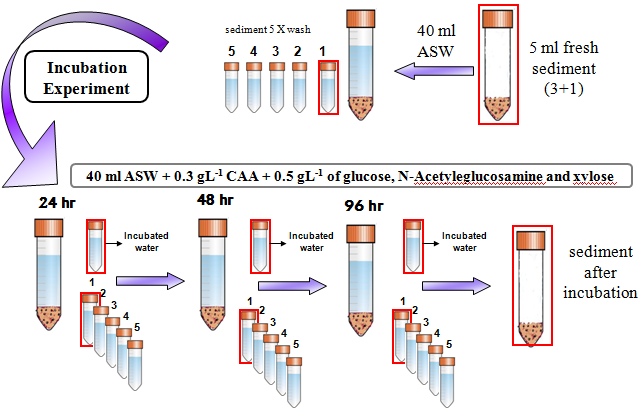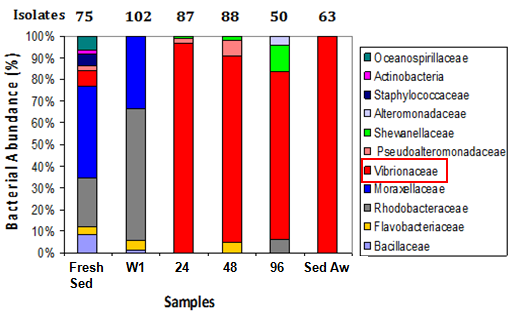"Microbial influence on sorption of heavy metals to Mn-(oxi)hydroxides"
Microbes have long been recognized as an important candidate, controlling directly or indirectly the global element cycles. Amongst these microbes, notably, the predominant role of Mn(II)-oxidizing microbes in the formation of natural Mn oxides, with enhanced heavy metal sequestrations at circumneutral pH have been widely accepted. However, their remarkable potential in the formation of Mn oxides and subsequent fate of heavy metals at acidic pH are enigmatic and profoundly lacking. One environmental site, featured by acidic pH and the occurrence of Mn oxides, is the former uranium mining site, Ronneburg, Germany. In this thesis, the elucidation of the microbial role in Mn oxide precipitation at acidic soil pH and subsequent Ni(II) sorption mechanisms at molecular scale implementing analytical, geochemical, microbiological and mineralogical (advanced synchrotron techniques) approaches, have been the subject of interests.
The data reported here proofed the presence of Mn- and Fe-enriched soil layers at the study site and the site can be considered as an extreme environment for microbial activities with relatively acidic soil pH (~ 4.5), high heavy metal loads and low carbon contents. Mn-phases at the site occur majorly as layer-type phyllomanganates, which are poorly crystalline hexagonal birnessites; an analogue of δ-MnO2 at acidic soil pH. It was also noticed that, these natural Mn oxides have preferentially sorbed and immobilized many metals including Ba, Ni, Co, Cd and Zn. Despite the consequences of extreme environment, several Mn(II)-oxidizing bacteria existed, being identified majorly as spore forming bacilli (Bacillus sp. and Brevibacillus sp.). Characterization of the products of Mn oxide formed in the presence of these bacteria using advanced X-ray techniques revealed that both strains produced very poorly crystalline δ-MnO2-like products that were encrusted around bacterial spores with unique morphological and mineralogical features. This phenomenon can be likely due to the species-specific mechanisms of Mn(II) oxidation. It was also demonstrated that Ni(II) preferentially associated with these biogenic Mn oxide products similar to the natural Mn oxides from the study site. The cultivable diversity approach to unveil the likely contribution of microbes in the formation of Mn oxides at the study site, showed specific abundances and diversity of bacterial Mn(II)-oxidizing communities (for e.g., members belonged to the groups, Firmicutesand Actinobacteria) considerably linked to Mn oxide-enriched layers rather than to adjacent soil layers. The X-ray absorption spectroscopy analysis of Ni(II) molecular-sorption mechanisms to Mn oxides provided fundamental insights that at acidic pH Ni(II) preferentially sorbed as triple-corner-sharing (TCS) complex and considerably contributed from both TCS and structurally incorporated into the vacancy sites at alkaline conditions.
In conclusion, the occurrence of poorly crystalline birnessite at the study site is intimately connected to biogenic Mn oxide products and thus, it is probably the initiation from microbial activities involving passive or active mechanisms. Few specialized microbial communities of Mn(II)-oxidizing bacteria are likely adapted to extreme environmental conditions and might have acquired the capacity to oxidize Mn(II). And, these biogenic Mn oxide products are extremely reactive mineral phases for many toxic metals from the same group in the Periodic Table appear to form sorption complexes similarly to that of Ni(II)-sorption complexes. From these perspectives, it is possible to anticipate potential applications in large-scale biotechnological applications such as bioremediation of contaminated soils, and groundwaters. Furthermore, in a broad scientific interest, biogenic Mn-oxides could also be used as, ‘biomarkers’ in acidic and(or) alkaline conditions in Mars, to infer paleoenvironmental conditions and major environmental and biological events in early earth history.
REFERENCES
Georg Buchel, Dirk Merten., 2009- Geo-Bio-Interactions at heavy-metal-contaminated sites. Chemie der Erde Geochemistry, Letter of the guest editors, S2, 1-3
Ehrlich H.L., 1997- Microbes and metals. Appl. Microbiol. Biotechno. 48, 697-692
SOIL PROFILING
SECONDARY MINERAL ENRICHED LAYER
MASTER THESIS
“Diversity of culturable attached-living bacteria from North Sea sediment”
The main purpose of this study is to elucidate the diversity of attached-living sandy intertidal sediment bacteria through culture-dependent and culture-independent studies and the assessment of the bacterial phylogenetic diversity from comparative sequencing of 16S rRNA genes. In addition, this study also focuses on the isolation of slow growing, yellow/orange pigmented and antibiotic resistant attached-living sediment bacteria. This is approached through washing steps and incubation experiments, thus enabling the isolation of some so far uncultured new bacterial strains. Hence, in a narrow sense, this study
provides the first extensive description of isolation of less active sandy
sediment bacteria. Additional information on enumeration and estimation of
sediment bacteria was obtained from quantitative analysis through culture
techniques and flow cytometry analysis.
Abstract
Bacteria may be one of the most abundant and species-rich group of organisms, and they mediate many vital ecosystem processes. Notably, attached-living bacteria are often larger, more versatile and are present in higher local concentrations than free-living bacteria in water. However, lack of sophisticated culture techniques hampers the isolation and diversity of attached-living sediment bacteria. In this study, the microbial community composition of Wadden Sea sediments of the German North Sea coast was investigated by culture-dependent and -independent techniques. Likely to winter condition with ambient temperature below zero, we recovered by direct plating approximately 10^4 CFU ml-1 of sediment, which was 10^4 times lower than previous studies. Analysis of 16S rRNA gene sequences from cultures revealed a high diversity of bacteria affiliated within the Gammaproteobacteria, Bacteroidetes, Alphaproteobacteria and Firmicutes. The most abundant classes of isolates from Wadden Sea sandy sediment were Gammaproteobacteria (61 %) and Alphaproteobacteria (24 %). A novel incubation approach toisolate diverse group of bacterial communities through 16S rRNA gene sequences yielded only a member of the Vibrionaceae. The frequent isolation of fast growing groups of Vibrionaceae suggests an efficient adaptation to the rapid temperature shift from below zero to 20 degree Celsius. However, our high throughput approach yielded also many slowly growing/less-active isolated and kanamycin resistant yellow or orange pigmented colonies. From 153 yellow or orange pigmented isolates 83% were affiliated to the family Flavobacteriaceae.

